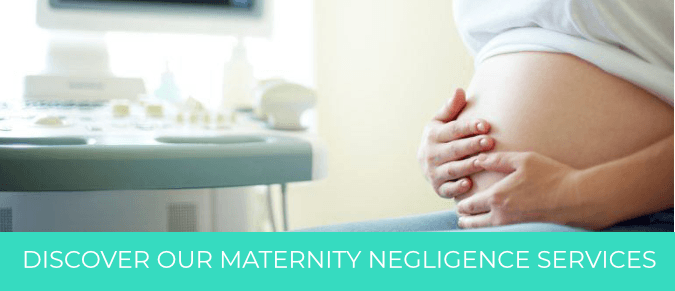
For most women pregnancy is an exciting time, but unfortunately this is not always the case.
As a qualified midwife for over twenty years, I’m pleased to be able to say that the majority of deliveries are joyous occasions but sadly I have encountered deliveries where things didn’t go to plan.
Thankfully with improvements in prenatal care many complications can be detected early to ensure that the mother receives the right level of medical care and support she needs to have a healthy childbirth.
Not every woman has a positive experience though. My career has now moved on and as a clinical negligence solicitor I am here to help women and their families when something goes wrong.
Below are some of the types of issues that I have seen first-hand either as a midwife or solicitor and that women should be able to receive compensation for so that they can benefit from the counselling and support they deserve after a traumatic labour.
Uterine Inversion
Uterine inversion is a potentially fatal childbirth complication which occurs when the placenta fails to detach from the uterus as it exits, pulls on the inside surface, and turns the uterus either partially or fully inside out during the third stage of labour. Thankfully it is very rare but when it does occur if undetected it can result in the mother going into shock and haemorrhaging. However, if the condition is noticed and treated promptly the uterus can be replaced, quickly limiting further problems.
Why does uterine inversion happen?
In my old midwifery book (Myles 9th Ed 1981) it says that uterine inversion occurs in 1:100,000 births. Wikipedia says 1:2000 births, although there are various statistics available. As a medical negligence solicitor, I have three clients who all suffered an inversion and have spoken to others who were too traumatised to do anything about it. My concern is that this may be happening more often that reported but women are unaware or feel unable to raise their concerns. Mismanagement of the third stage is said to be the main cause of an inverted uterus. It is important for a midwife to understand the process to safely deliver the placenta and membranes. You cannot rush it, although you can give an oxytocic to speed up the process and make it safer. The oxytocics Syntocinon or Syntometrine were the ones that I used, with Ergometrine occasionally. This is called a managed third stage. These drugs cause the uterus to contract. You need a contraction to shear the placenta off the uterine wall. Until this happens you cannot apply traction to the cord or there is a risk of inverting the uterus. Some women prefer to wait for the placenta to separate by itself, although this can take longer.
There are signs that the placenta has separated such as sudden bleeding and/or a lengthening of the cord. It is important that the midwife waits for these signs before re-commencing gentle traction. The mother must not push at the same time as this increases the risk of an inversion.
There are other reasons for the uterus inverting, such as a short umbilical cord, multiple pregnancy and previous uterine inversion. However, the ones near the top of the list are excessive fundal pressure, premature cord traction before the placenta has separated and excessive traction on the cord. These all relate to management by the midwife. Junior midwives need support to appreciate what can happen if the third stage is rushed.
My clients that have suffered such a trauma have significant psychological consequences. All have developed post-traumatic stress disorder which affected them from months to years after the event. Two of my clients’ cases are ongoing. The third case settled and allowed my client to access psychological therapy. She was delighted when she was able to collect her daughter from school for the first time in 18 months. She was too nervous to leave her home in case something happened or she bled.
With birth rates in the UK rising and midwife shortages a major issue for the NHS, it’s important that the signs are spotted early so that action can be taken.
Failed anaesthetic
This may seem like a storyline from Holby City or Casualty but I have two clients who suffered this trauma and unfortunately, both were delivered in the same trust.
In both cases labour had progressed to a certain point and the baby became distressed. Both women had epidurals for pain relief and there had been intermittent involvement from the anaesthetist after the epidural had been sited. In one case the epidural worked very well initially. However, it stopped working after a few hours. The anaesthetist was busy elsewhere and was unable to attend. Pethidine was given for pain relief.
Some time later a decision was made to perform a caesarean section. The anaesthetist performed checks and the mother advised that she could not feel the cold spray in some areas, but was not as numb as she expected to be. Unfortunately, the anaesthetist did not stop the procedure until it was clear that the mother was very distressed. By this time she was very frightened and had to be given more pain relief and did have a general anaesthetic. It was clear when reviewing the records that the mother’s heart rate had risen at around the time of the first cut and did not lower until the pain relief took effect.
Some years later she is now pregnant again and terrified of having her baby. This is very sad and is not the way she should be spending her pregnancy. I am pleased to say that this is something I have only encountered twice so is indeed a very rare complication.
Compensation was awarded to one client and negotiations are in hand for the other. This will enable psychological therapy to help them cope with what happened so that they can enjoy rather than fear another pregnancy.
Episiotomy Suturing
This is a condition that I encountered on the labour ward as a midwife and is one that is hard to forget. This can occur following suturing of the perineum after a tear or episiotomy. The woman that I looked after many years ago had a haematoma. Surgery helped the pain ease back to normal post-partum discomfort.
I also have a client who did have a haematoma that was not diagnosed at the time. It was her first baby so she was unaware of what level of pain she should be in. She did say that she was in pain, but was told that this was normal. She did not have a thorough examination of her perineum as specified in Nice CG37 2006 that may have identified the problem at an earlier stage.
She was discharged home and the midwife visited the following day. She was transferred back to hospital and attempts were made to examine her which were too painful. This in itself should have indicated a problem. Antibiotics were offered initially but it took nearly two years before she had the surgery that she required. She suffered needless pain and difficulty in day to day activities during that time.
The issue here was that time was not spent with this mother postnatally to determine whether her pain was normal or not. In this case it appears that the suturing was not performed to an acceptable standard. Perineal haematomas can just be an unfortunate complication; however, it is important to recognise them early and to treat quickly.
When I trained as a midwife, I spent the majority of my time on the wards looking after pregnant women, delivering their babies and learning from more experienced midwives. I had plenty of time and support to deliver many babies during day and night shifts and to come across complications in a safe and supportive environment.
Midwives now spend much more time in university and less time experiencing the wards before they qualify. This means that they are very well qualified and educated and can consider evidence based practice. However, in my opinion it’s the practical experience that really makes a good midwife and ultimately a safe pair of hands to guide you through your labour.
Maternity wards are very busy places and the news is always stating how short of midwives we are so these issues are not surprising. However, I am always disappointed when woman approach me with the three complications above, especially, when further evidence reveals that the situation could have been avoided. We need to ensure that our midwives are empowered with the knowledge and experience to do their jobs as well as they possibly can and that women receive the support they deserve when things don’t go to plan.
If you have been affected by any of the issues above or want to speak to someone confidentially about complications in your labour, please get in touch and I would be happy to advise you.










